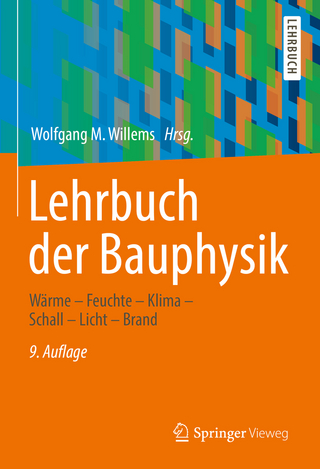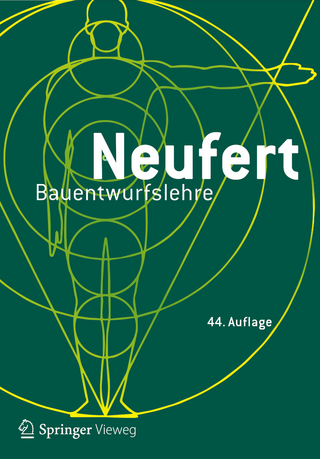
Building Sustainability in East Asia
Wiley-Blackwell (Verlag)
978-1-119-27700-2 (ISBN)
Building Sustainability in East Asia: Policy, Design and People illustrates the holistic approaches and individual strategies to building sustainability that have been implemented in construction projects in Asia. Top-down and bottom-up approaches (from formulating policy to constructing individual buildings) are effective in terms of the sustainable development of cities, and this book covers both, illustrated with a range of case study developments.
Vincent S. Cheng is Director of the Building Sustainability Group at Arup in Hong Kong. Dr Cheng has 20 years of professional experience in building energy efficiency and is an expert in sustainable master planning and building design, specialising in green code formulation, HK-BEAM and LEED assessment, life-cycle analysis and Air Ventilation Assessment (AVA) and District Cooling Systems (DCS). He is Council member of HK Professional Green Building Council and represents the Arup HK office on the Arup's Sustainability Task Force. Jimmy C. Tong is East Asia Energy Skill Leader and an Associate at Arup in Hong Kong, focusing on Building Sustainability. Dr Tong has expertise in energy systems in various sectors, including wind, solar, and other renewable energy, infrastructure and building services, and product and system development, and his current focus is creating and transforming cities and buildings toward a greener future.
About the authors xi
Foreword xii
Preface xiv
Acknowledgement xvii
Section 1 On contexts 1
1 Introduction 3
1.1 Why sustainability matters 3
1.2 Why Asia matters 4
1.3 Why buildings matter 5
1.3.1 Root causes and solutions to the problem 6
1.3.2 Eco‐city principles 6
1.3.3 Liveable spaces 7
1.4 Dimensions of sustainable development 8
1.4.1 Policy support 8
1.4.2 Green market and consumption 9
1.4.3 Technology push 10
1.5 Sustainability in practice 10
1.5.1 History of green building in Asia 11
1.5.2 Capacity building – green professionals 11
1.5.3 Sustainable change for the green movement 15
1.6 Organisation of the book 15
2 Rapid urbanisation 16
2.1 Introduction 16
2.2 Asian urbanisation in context 16
2.3 Demographic changes 17
2.3.1 Global population trends 17
2.3.2 Urban population growth 18
2.3.3 The challenge of an ageing population 21
2.4 Economic changes 22
2.4.1 Growth in GDP 22
2.4.2 Increased income 22
2.4.3 Consuming society 24
2.5 Social changes 25
2.5.1 Housing needs 25
2.5.2 Employment needs 26
2.6 New growth model 26
2.6.1 Mega and compact cities 27
2.6.2 Green building markets 28
2.7 Summary 29
3 Urban environmental challenges 30
3.1 Introduction 30
3.2 Urban challenges in context 31
3.3 Climate change challenges 32
3.3.1 Vulnerability to extreme weather 32
3.3.2 Global warming 34
3.4 Urban environmental degradation 37
3.4.1 Air pollution 37
3.4.2 Energy depletion 39
3.4.3 Waste generation 42
3.4.4 Unhealthy urban environment 42
3.5 Liveability degradation 43
3.5.1 Urban heat Island 43
3.5.2 Ecological footprint 44
3.6 Summary 45
4 Quest for solutions 46
4.1 Introduction 46
4.2 History of international collaborations and partnerships 47
4.3 C40 cities climate leadership group initiative 47
4.3.1 Key issues 49
4.3.2 Action plan on buildings 49
4.4 WEF partnership for future of urban development 50
4.5 Regional integration 52
4.6 Changes for solutions 53
4.6.1 Re‐think of sustainable development framework 53
4.6.2 Issues of policy 54
4.6.3 Issues of practice/design 55
4.6.4 Issues of people 55
4.7 Paradigm shift 56
Section 2 On policy 57
5 Policy framework 59
5.1 Introduction 59
5.2 Policy framework 60
5.3 Policy priorities 61
5.3.1 The moving target 61
5.3.2 Prioritisation of policy issues 63
5.3.3 The Asian way of change 71
5.4 Policy instruments 71
5.4.1 Regulations and standards “The Stick” 73
5.4.2 Economic instruments “The Carrot and Stick” 74
5.4.3 Voluntary schemes instrument 74
5.5 Institutional arrangements 76
5.5.1 Hierarchy – who to lead 76
5.5.2 Government coordination and authority 78
5.5.3 Proposal for eco‐city implementation 79
5.6 Summary 80
6 Policy implementation 81
6.1 Introduction 81
6.2 General approach 81
6.3 Review of the regulations 83
6.3.1 Building energy regulations 84
6.3.2 Planning control for a better environment 86
6.4 Market solutions 87
6.4.1 Incentivising the market 87
6.5 Market‐based approach 90
6.5.1 Green building certification 90
6.5.2 Sustainability report and index 90
6.6 Public‐private partnership (PPP) 91
6.7 Collaboration with private sector 93
6.8 Capacity building 94
6.8.1 Demonstration projects and research and development 94
6.8.2 Education and training of green practitioners 95
6.9 Summary 96
Section 3 On design 97
7 Sustainability transformation 99
7.1 Introduction 99
7.2 Green transformation of building industry 100
7.2.1 Engaging stakeholders 100
7.2.2 Empowering the practitioners 102
7.3 Practice of building sustainability 103
7.3.1 Definition of sustainable building 103
7.3.2 Standardisation of practice 106
7.4 Sustainable building in action 107
7.4.1 Life‐cycle consideration 107
7.4.2 Design stage – integrated design 110
7.4.3 Construction stage – sustainable materials 113
7.4.4 Operation stage – behavioural changes 120
7.5 Building information modelling 121
7.6 Summary 123
8 Engineering solutions 124
8.1 Introduction 124
8.2 Design provisions for sustainable building 125
8.3 Adaptation to climate change and resilient designs 125
8.3.1 Extreme wind engineering 125
8.3.2 Flood mitigation and prevention 128
8.3.3 Seismic design 129
8.3.4 Fire engineering 130
8.4 High‐performance buildings 130
8.4.1 Building physics analysis 132
8.4.2 Energy appraisal 133
8.4.3 Indoor environment quality 133
8.4.4 Outdoor environment quality 135
8.5 Design innovations 135
8.5.1 Outside building: High‐performance envelope 137
8.5.2 Inside building: Low energy and carbon designs 143
8.6 Summary 146
9 De-carbonisation 147
9.1 Introduction 147
9.2 Building energy performance 148
9.3 Low/zero carbon design 152
9.3.1 Definition of zero carbon 152
9.3.2 Design strategy 152
9.4 Renewable energy for urban developments and buildings 158
9.4.1 Solar energy 160
9.4.2 Wind energy 162
9.4.3 Bioenergy 162
9.4.4 Hydropower 163
9.4.5 Marine/ocean energy 164
9.4.6 Geothermal energy 164
9.5 District‐wide de‐carbonisation 167
9.5.1 Micro‐energy grid 167
9.5.2 District energy 169
9.6 Towards a low‐carbon and smart city 172
9.7 Summary 173
Section 4 On people 175
10 Space for people 177
10.1 Introduction 177
10.2 Urban context of Asia city 178
10.2.1 Liveability 178
10.2.2 A compact and vertical city 178
10.2.3 An undesirable building environment 180
10.3 The quest for a quality built environment 181
10.3.1 A novel planning framework for the environment 181
10.3.2 The urban climatic map 182
10.3.3 Air ventilation 184
10.3.4 Microclimate and landscape design integration 184
10.4 Reducing the urban heat Island 187
10.5 Street canyon effect – roadside air pollution 191
10.6 Right of light 193
10.7 Health and well‐being 193
10.7.1 Natural ventilation 194
10.7.2 Daylight for habitation 194
10.7.3 Water quality 196
10.8 Summary 197
11 Community making 199
11.1 Introduction 199
11.2 Sustainable community 200
11.3 Community‐based design 201
11.3.1 Cultural aspect (social) 202
11.3.2 Placemaking (environment) 202
11.3.3 Sustainable housing (economics) 202
11.4 Neighbourhood assessment 206
11.4.1 History of overseas schemes 206
11.4.2 Definition of community/neighbourhood 207
11.4.3 Assessment aspects/categories 208
11.5 Development of BEAM plus neighbourhood in Hong Kong 210
11.5.1 Landscape and ecology in built environment 212
11.5.2 Stakeholder engagement 213
11.5.3 The establishment of BEAM plus neighbourhood 215
11.6 Summary 216
12 Low carbon living 217
12.1 Introduction 217
12.2 Carbon footprint of urban living 217
12.3 Behavioural changes 219
12.4 Changes in design culture 220
12.4.1 Task lighting 221
12.4.2 Thermal comfort 221
12.4.3 Natural ventilation 221
12.4.4 Green products 222
12.4.5 Smart metering 222
12.5 Eco‐education 222
12.6 Zero energy living experience 226
12.7 Community centre 228
12.8 Urban farming 230
12.9 Living LOHAS 231
12.10 Summary 234
Section 5 Way forward 235
13 Conclusions 237
On contexts … 237
On policy … 238
On design …. 238
On people …. 239
Way forward …. 239
References 240
Index 250
| Erscheinungsdatum | 28.04.2017 |
|---|---|
| Verlagsort | Hoboken |
| Sprache | englisch |
| Maße | 173 x 246 mm |
| Gewicht | 726 g |
| Themenwelt | Technik ► Architektur |
| Technik ► Bauwesen | |
| ISBN-10 | 1-119-27700-0 / 1119277000 |
| ISBN-13 | 978-1-119-27700-2 / 9781119277002 |
| Zustand | Neuware |
| Haben Sie eine Frage zum Produkt? |
aus dem Bereich


